The School of Nursing’s southern red oak
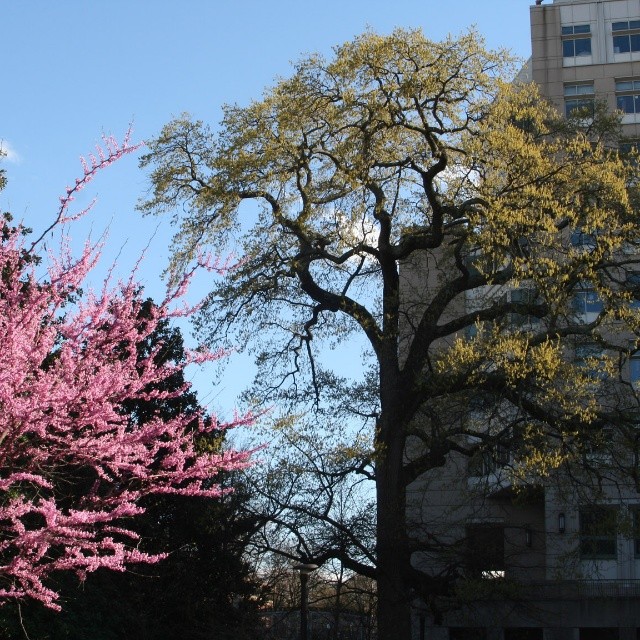
In an interview, I was once asked what was my favorite tree in the arboretum. The question caught me off guard and I think that I said that it was the persimmon tree in front of Branscomb quad. Although that is a very interesting tree, I knew immediately afterward that I had given the wrong answer. There is no question that my favorite tree is the big southern red oak (Quercus falcata) that grows in front of the School of Nursing between the parking lot and 21st Ave. S.
There are many reasons to like this tree. Although Quercus falcata is relatively common in the Nashville area, southern red oak 2-123 is the only member of its species in the arboretum. This particular tree is also huge! It is in a four-way tie for largest tree at Vanderbilt, and at 32 meters (105 ft.) it is tied with two other trees for the title of tallest tree on campus. It also has an impressive crown spread of 28 meters (90 ft.) and the sixth largest diameter (132 cm or 52 inches) of any tree in the arboretum.

But the reason why it’s my favorite tree is because I love it’s profile as seen from the “front porch” of MRB III. On most days for about eleven years, I would cross over the 21st Ave. S. bridge from Peabody after dropping my kids off at school, and walk towards main campus on the skywalk that runs between 21st Ave. and MRB III. Just as I would emerge from the overhanging building, there it was, with its swirling branches rearing up in front of me like a giant bonsai. I have often wondered if MRB III was designed to take advantage of this striking view of oak 2-123. I doubt it, but it’s fun to think that it might be true!
Why is it called “Quercus falcata”?

Southern red oak falls into the “red oak” group of oaks, which means that its leaves have pointed lobes. However, its leaves differ from northern red oak (Quercus rubra) in several ways. Quercus falcata leaves have much narrower lobes and the sinuses between the lobes are much more deeply indented than Q. rubra. The lower surface of Q. falcata leaves are densely hairy and Q. rubra leaves are not. But the really distinctive thing about Q. falcata leaves is that they tend to have very long and narrow terminal lobes. This narrow lobe also tends to bend to one side (“falcate” = curved like a sickle), which is the characteristic that gives the species its scientific name. The next time you walk from main campus to Peabody across the bridge, look for dead leaves at your feet and you will see many leaves like this that have blown from oak 2-123 onto the skywalk.
How old is southern red oak 2-123?
Over the past several years, I have been working to understand the age of trees in the arboretum. On a page in the arboretum website, I described how I used a series of aerial photos to try to establish the age of some of the largest trees that were in the vicinity of the central library. I concluded that there were four large oak trees in that area that probably qualified as “McTyeire legacy trees” by being visible on photos dating back to the 1930’s and are large enough to have been planted during the first few decades of Vanderbilt’s existence as a university. Southern red oak 2-123 is one of those four trees, which means that it was probably planted sometime between the founding of the university in 1875 and 1900.
One problem with the analysis of aerial photos is that as you go back in time, it is harder to find landmarks to orient yourself. Not only do existing buildings disappear, but many trees that are now gone begin to appear. A tree that is giant and unmistakable in a current photo is just one of many medium-sized trees in 1930. Because the School of Nursing building is one of the older buildings in campus (built in 1925), it provides a stable landmark back to the earliest aerial photographs. However, it is still difficult to decide exactly which of the trees growing between that building and 21st Ave. S. is oak 2-123. In fact, I now know that I was off when I marked its position on the photos on the page in the arboretum website. Read on and you’ll know how I found that out.
Help from the sidewalk

On one of my recent forays to the University Archives, I was talking to Phil Nagy, who has helped me locate some of the historical photos that I’ve used in my research on the trees. He showed me one of his favorite photos, one that was taken from the front door of Godchaux Hall, the original building in the School of Nursing. The photo is very interesting because it shows that the sidewalk from the front door to 21st Ave. S. was build around two of the trees in front of the building. When I saw that photo, I did a double-take. Certainly one of the trees in that photo had to be southern red oak 2-123! I ran over to Godchaux, stood in the front door and snapped a photo with my phone so that I could compare it to the photo from the archives. Sure enough, the nearest of the two trees in the middle of the sidewalk was my favorite tree!
I was really excited about this discovery for several reasons. One was because it made it clear to me exactly where 2-123 was located – if the sidewalk were visible in an aerial photo, I could easily find the tree. The same day I first saw the sidewalk photo, I also acquired one of the best early aerial photos from the archives. It showed the Peabody College campus and the part of the main campus nearest 21st Ave. S. very clearly on a winter day sometime between 1928 and 1932. In this photo, the positions of many trees were very distinct and unobstructed by leaves.

When the image is enlarged to show the vicinity of the nursing building, there is 2-123, right in the middle of the sidewalk! (You may enjoy looking at the entire image, which shows the environs of Vanderbilt, including the relatively new Dudley Field stadium and the Parthenon. Notice how relatively undeveloped the area is near the horizon.)
The oak and the School of Nursing

The image of 2-123 growing in the sidewalk was not dated, but when I was rummaging around on the School of Nursing’s historical web pages, I made another fun discovery. The website had an image of the front cover of “The Micron“, a student publication of the School of nursing from 1925 to 1929. And on that cover was the photo from the archives! Clearly this photo has been popular for a long time!
This puts the possible date for the image within a fairly narrow range. Godchaux Hall was built in 1925, so the image must have been taken sometime between then and the end of publication of The Micron in 1929.
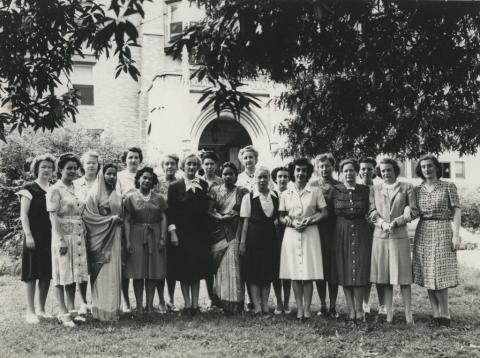
I also did some searching of images in the Eskind Biomedical Library Special Collections online photographic exhibit to see if I could find any interesting images of trees around Godchaux Hall. I was not disappointed. I found a great image from 1946, which showed participants of a Rockefeller Foundation program standing in front of the Nursing School. I’m developing a reputation now of not really caring that much about the people and buildings in historical photos when I can see interesting things about the trees. This photo is no exception.
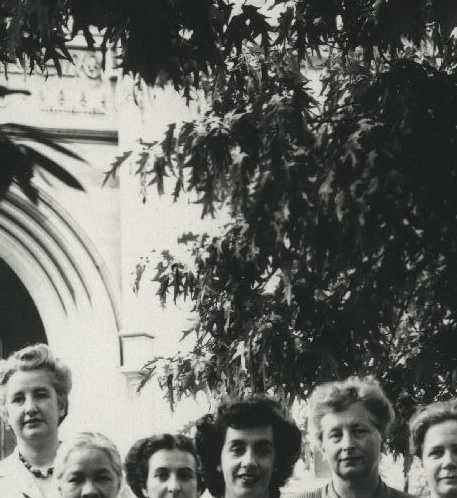
If you enlarge the section of the image just to the right of the door, you can clearly see the falcate terminal lobes of our old friend, southern red oak 2-123!
Nerdy data stuff
Having these great photos not only documents the history of my favorite tree visually, but they also make it possible to collect data to know how its size has changed from c.1928 to 2015.
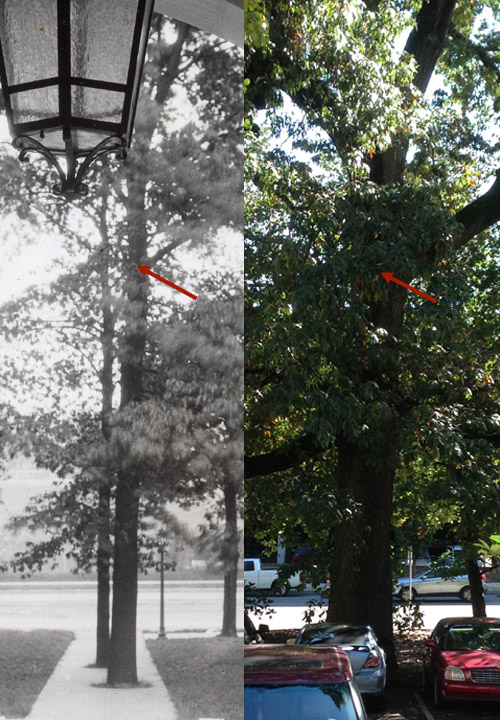
In the images above, I’ve enlarged them so that they are at approximately the same scale. The red arrows mark the branching point of a major side branch clearly visible in both images. The distance from this branch to the base of the tree can be used to establish the relationship between the pixel size in each image. I can also measure the diameter in pixels of the tree in both images, using the cars in the image at the right to estimate position of breast height. I know from my measurements that the current diameter at breast height is 132 cm, so by using the pixel proportions established from the branch height, I can establish that the diameter in 1928 was about 47 cm.
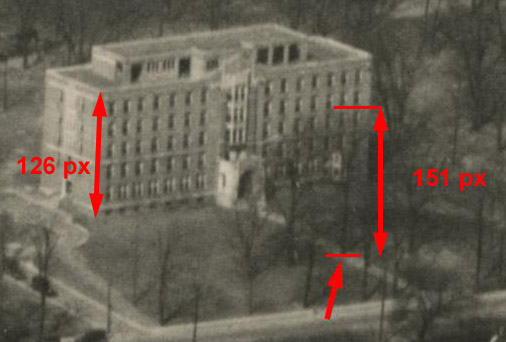
In the image above, it is quite easy to see the base of the trunk of oak 2-123. The top is a little harder to delineate, but I can make a reasonable estimate. By measuring the height of the School of Nursing building and the tree in pixels, I can know the height of the tree relative to the building. I made several estimates of the current height of the building and arrived at a value of 13 meters. Using proportions, this indicates that the height of the southern red oak was about 15.6 meters when the photo was taken in about 1930.
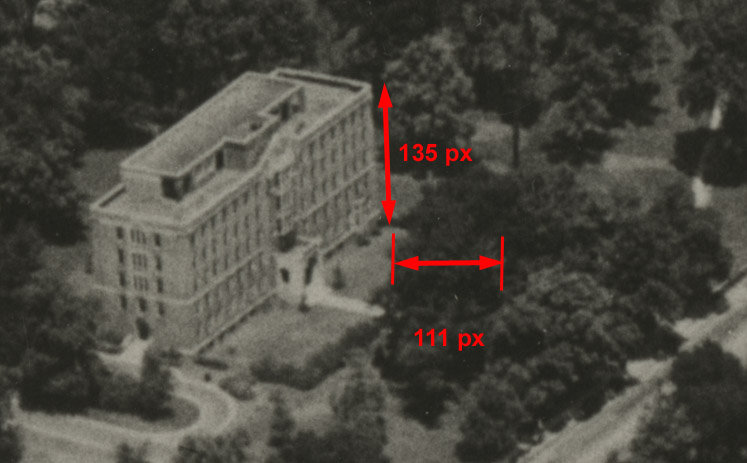
The picture above was taken in the mid-1930’s, so the tree was probably about 5-10 years older than in the previous photos. It was taken in the summer, so it is easier to distinguish the crown of the tree. Again, by comparing with the height of the Nursing School building, we can establish the relative sizes of the building and the crown spread. Using the 13 meter value for the building height, we arrive at a crown spread of about 10.7 meters.
So here are the data:
| year | diameter (cm) | diameter (in.) | height (m) | height (ft.) | crown spread (m) | crown spread (ft.) |
| 1925-35 | 47 | 18.5 | 15.6 | 51 | 10.7 | 35 |
| 2014 | 132 | 52 | 32 | 105 | 27.5 | 90 |
From these data, we can see that the School of Nursing’s southern red oak has grown a lot in 90 years: it’s twice as tall, and its trunk diameter and crown spread are about three times as big. If my conjecture is true that oak 2-123 and the many other similar sized trees seen in the 1925-35 photos were among the 1500 trees originally planted by Bishop McTyeire in the early years of the university, they would be about 50 years old in those photos. This could be checked for reasonableness by finding oak trees on campus that were planted in about 1965 and comparing their current sizes with the estimated size of 2-123 in 1930.
Enjoy the tree !
Now that you know a few facts about the School of Nursing’s amazing southern red oak and a little of its history, I hope you will notice and enjoy it the next time you walk from the Peabody bridge towards main campus.
If you follow the arboretum on Instagram (profile name: vutrees), you’ll notice that I used the photo below for the arboretum’s profile picture. Are you surprised?


Steve Baskauf is a senior lecturer in the Biological Sciences Department at Vanderbilt University. He serves as the communications coordinator for the Vanderbilt Arboretum and can be contacted at steve.baskauf@vanderbilt.edu. Posted 2015 December 7. Unless otherwise noted, the images on this page were photographed by him.